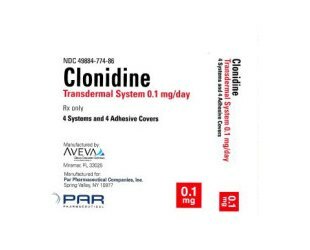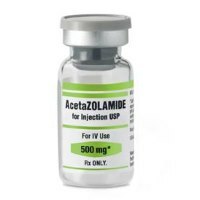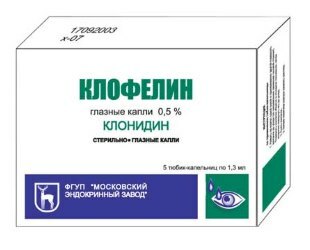
Pharmacological action
Clonidine is an antihypertensive agent of central action.
The main mechanism of action due to stimulation of all postsynaptic α2-adrenergic receptors is the vasomotor center of the medulla oblongata, and also gradually reduces the flow of all sympathetic impulses to the heart and vessels at the presynaptic level.
The resulting hypotensive effect is due to a decrease in heart rate, a sharp decrease in OPSS and cardiac output.
- 1. Pharmacological action
- 2. Indications for use
- 3. Contraindications
- 4. Side effects
- 5. Dosage and administration
- 6. Drug Interactions
- 7. Specific instructions
- 8. Composition and Form Release
- 9. Storage conditions and shelf life
- 10. Average cost in Russia and Ukraine
- 11. Analogues
- 12. Reviews
In case of rapid administration, it is also possible to short-term increase in blood pressure, which is due to stimulation andof postsynaptic α1-adrenergic receptors.
Renal blood flow also increases;increases the tone of the vessels of the brain, and also reduces cerebral blood flow and has a rather pronounced sedative effect.
The duration of the therapeutic effect is 6-12 hours.
During instillation in the conjunctival sac, the intraocular pressure usually decreases due to adrenostimulating local action, which results in a decrease in production of the intraocular fluid and an improvement in its outflow. In addition, due to the weakening of the sympathetic tone, which is due to the central effect of the active substance, part of it undergoes resorption.
Indications for use
Clonidine is often prescribed only in emergency and emergency situations.
The main indications for his appointment can be the following cases:
- severe degrees of hypertension, with the possible development of complications;
- hypertensive crisis;
- in cases of open-angle glaucoma.
This is the official version. In fact, this drug is used only to treat hypertensive crises( with a lot of conditions).
Contraindications

The main contraindications are:
- Propensity to bradycardia, hypertension and at the risk of developing cardiogenic shock.
- Diseases that affect the brain vessels: aneurysms, atherosclerosis and so on.
- Severe rates of atrio-ventricular blockade.
- Various obliterating diseases of peripheral vessels.
- Postponed myocardial infarction.
- Alcohol intake, pregnancy, possible depressive conditions.
- Particularly severe forms of hepatic insufficiency.
Administration of Clonidine as eye drops is absolutely contraindicated only in one case: if the patients have infectious inflammation of the eye tissues( mainly - the anterior part of the eye).
Side effects

When using this drug without them anywhere. A particularly strong drug is a great danger.
Here is a complete generalized list of all those phenomena that arise under the action of the drug Clonidine:
- Bradycardia.
- Asthenic syndrome: drowsiness, weakness, sensation of stupor, a sharp change of mood or depression. Dizziness and headache.
- Various allergic manifestations: rash on the skin, like hives.
Prolonged administration of Clonidine usually leads to the loss of fluid in the body. This is easy to notice: at the outset, feet, shins and ankles swell. In such situations, diuretics should be prescribed.
A sharp introduction of the drug Clonidine intravenously can cause a "paradoxical" reaction: the arterial pressure rises for a while, and then drops sharply. Do not forget that after the introduction of this medication the most sensible will not get out of bed within 1-2 hours.
Eye drops with clonidine can cause various symptoms of conjunctivitis: redness of the conjunctiva, itching and burning sensation in the eyes.
Dosage and administration of
Drug administration is necessary parenterally, inwardly, sublingually, as instillation in the eye( droplets).The treatment schedule and dose are strictly individual.
Drug Interaction
In patients who receive beta-blockers, with a sudden withdrawal of clonidine, blood pressure may rise sharply. Scientists believe that all this is due solely to the increase in the content of the substance of catecholamine in the circulating blood, and also by the intensification of their vasoconstrictor action.
In case of simultaneous application of hormonal contraceptives, the sedative effect of Clonidine may be enhanced.
With the combined use of clonidine with various tricyclic antidepressants( imipramine, desipramine or clomipramine), the antihypertensive effect of the Clonidine preparation may decrease. In the case of simultaneous application with Clonidine, it is also possible to gradually increase the duration of action of Vecuronium.

Please note - instructions for use on acetazolamide. How correctly to make a dosage?
In the article( tyts) all the analogues of clonidine.
Vitamins for eyes to improve vision!http: //moezrenie.com/lechenie/ vitaminy.html
Simultaneous use with verapamil is an opportunity for development in patients with arterial hypertension of cardiac blockade.
In addition, it is believed that Clonidine is able to suppress the increased production of catecholamine substances that occurs as a result of hypoglycemia, as well as symptoms of hypoglycemia( palpitation, tachycardia and increased sweating) due to the effect of catecholamine substances. In addition, there are reports that the drug Clonidine significantly increases the blood glucose, due to a sharp decrease in the secretion of insulin. It is important to take this into account in the case of simultaneous application of insulin.
In the case of switching from the application of clonidine to the drug Captopril, the gradual antihypertensive action of the latter develops. With the sudden withdrawal of the drug Clonidine in patients who receive Captopril, there may be a sharp increase in blood pressure.
There are reports of a gradual decrease in the efficacy of pyribedil and levodopa in people with Parkinson's disease.
In the case of simultaneous application of clonidine with prazosin, there is a change in the antihypertensive effect of the drug Clonidine.
Joint application of the drug propranolol or atenolol may develop additive hypotensive effect, dry mouth or sedative effect.
Simultaneous application with Cyclosporine there is a report of a gradual increase in plasma concentrations of Ciclosporin.
Specific instructions

C should be used with extreme caution after a recent history of myocardial infarction and chronic renal failure.
In the event of a sudden discontinuation of therapy, withdrawal may develop: nervousness, increased blood pressure, tremors, headaches and nausea.
Carrying out therapy with clonidine together with beta-blockers, in the event of discontinuation of therapy in order to avoid high blood pressure, it is necessary to finish the treatment with beta-blockers first, after which it is required to stop the use of Clonidine by slowing down the dose.
When Clonidine is administered to prevent orthostatic hypotension, the patient must lie at the time of injection and within 2 hours after the administration.
In case of no effect, discontinue the drug within 2 days. To reduce the systemic effect of the drug immediately after instillation, you need to press your finger for 2 minutes with the area of the lacrimal sac.
Influence on driving
At the time of treatment it is important to avoid dangerous activities that require sharp psychomotor reactions and increased attention.
Composition and Form Release
This is a synthetic preparation. The main active ingredient is clonidine hydrochloride.
Issued in the following types:
- in the form of tablets at 0,075, as well as 0,15 mg, packs of 10 or 50 pieces;
- in the form of 0.01% solution in ampoules for injections of 1 ml, packs of 10 ampoules;
- in the form of eye drops 0,125, 0,25, and also 0,5% in special tubes-droppers, which contain 1.5 ml of the drug, packs of 2 tubes of a dropper.

Editorial recommends - eye drops with cataracts. What will help to overcome the disease?
In the news( here) eye drops for newborns from conjunctivitis.
Ophthalmic clinic of Fedorov in St. Petersburg!http: //moezrenie.com/kliniki/ glaznaya-klinika-fedorova.html
Storage conditions and expiration date
Store this medication only at room temperature, out of the reach of children and also away from light.
Shelf life of the drug:
- tablets - 4 years;
- eye drops - 2 years;
- ampoule - 3 years.
Average cost in Russia and Ukraine
In Russia, the average cost of Clonidine is 92 rubles, and in Ukraine - 14 hryvnia.
Analogues

An excellent analogue of this drug is Klofelin, the average cost of which is 83 rubles.
Reviews
Patients who used this medication for treatment, speak of it only positively. Read more reviews at the end of this article.
